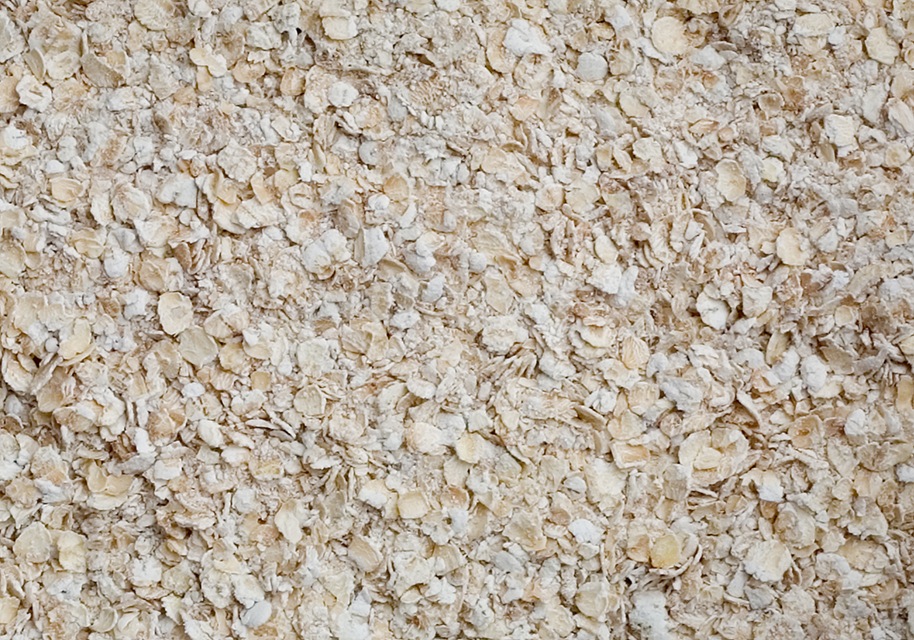My friend - and international renowned model Kerstin M. - told me the other day, while we were having coffee at Starbucks, about this new workout routine called Physique 57®. Since she seemed really into it (and told me a lot of deal about it) I got curious, did some research and then decided to give it a try.
Physique 57?
April 8, 2011
April 6, 2011
Today I want to give some room to my favorite cereal, one that makes all my mornings a little bit better: oatmeal!
I like to say that oatmeal is it’s a perfect 10. You can eat it at breakfast to propel you through sluggish mornings, a couple of hours before a workout to feel fully energized by the time you hit the weights, or at night to avoid a late-night binge.
Oatmeal can be far more than just your breakfast cereal, it can help you make it through your day no matter what you're up to.

Oatmeal can be far more than just your breakfast cereal, it can help you make it through your day no matter what you're up to.
April 3, 2011
Already for some time I wanted to write something on the interaction between Bikram Yoga (but I might add yoga in general) and triathlon (or any endurance sport): two worlds that look so far apart but that are in reality so close.
So now the time has come and here’s what I have to say about it.
Let’s start by reminding ourselves that triathlon is a multi-sport event involving the completion of three continuous and sequential endurance events that in its most popular form, involves swimming, cycling, and running in immediate succession over various distances. Triathletes compete for fastest overall course completion time, including timed "transitions" between the individual swim, bike, and run components.
While Bikram is is a system of yoga that consist of a set series of 26 postures and 2 breathing exercises. Bikram Yoga is ideally practiced in a room heated to 105°F (more or less 40.6°C) with a humidity of 40%. For more info you should read this article “The Awesomeness of Bikram Yoga”
So at this point you might think: “Ok, dude what is the link between this two very different forms of exercising?”
I know, that sounds a little bit like a stretch but I will explain you why and how those two worlds are actually very close!

Training for triathlons
As a triathlete, I spend anywhere between 15-25 hours each week swimming, biking and running in order to prepare for my triathlon races.
Consequently, I am constantly stressing my body physically. I do not have the time, the energy or even the motivation to do something “extra” just for the sake of doing it.
Bikram Yoga classes are 90 minutes long and since I have a very high metabolism I will sweat out 9 pounds of water in a class (no kidding, they call me waterfall at the studio where I pratice!). When you count travel time along with the need to arrive a few minutes early and stay a few minutes late, each class becomes a minimum 2 ½ hour time commitment. On top of my swimming, biking and running, I make the time to take 2 to 4 yoga classes each week – a 4 to 8 hour time commitment.
So why do I still do Bikram Yoga?

Last year, I competed in several triathlons with very good results (actually some of the best in my career) andI attribute my success in a large part to regular Bikram Yoga practice.
Because of the high volume of repetitive movements, it is not uncommon for triathletes (like me) to frequently sustain overuse injuries such as Achilles tendinitis, rotator cuff issues, knee tendinitis and back pain (from the bike). Because I live for triathlon, I want to minimize any incidence of injury. And let me tell you I haven’t missed a day of training due to injury in a very long time.
In my opinion, there are three primary reasons why endurance sports athletes should consider practicing yoga:
(1) Increased flexibility. As a multisport athlete, we need a full range of motion in order to be more efficient in our movements.
(2) Improved core and stabilizer muscle strength. Because we maintain the same positions for extended periods of time, we need a strong core and strong joints to support our bodies.
(3) Both of the above will help reduce the likelihood of overuse injuries.
Consistency in training is a key success factor in endurance sports. It’s difficult to be consistent when injured.
At the end of the day, I truly believe that the 4 to 8 hours of time that I invest in the studio each week pays itself back many times over through improved overall health, which directly translates into improved performance for my passion: triathlon.

Bikram Yoga may not be the right yoga for everyone, but I would strongly recommend some form of yoga to anyone. And especially if you’re an endurance sport athlete you should seriously give it a thought!
TheIronYou
So now the time has come and here’s what I have to say about it.
Let’s start by reminding ourselves that triathlon is a multi-sport event involving the completion of three continuous and sequential endurance events that in its most popular form, involves swimming, cycling, and running in immediate succession over various distances. Triathletes compete for fastest overall course completion time, including timed "transitions" between the individual swim, bike, and run components.
While Bikram is is a system of yoga that consist of a set series of 26 postures and 2 breathing exercises. Bikram Yoga is ideally practiced in a room heated to 105°F (more or less 40.6°C) with a humidity of 40%. For more info you should read this article “The Awesomeness of Bikram Yoga”
So at this point you might think: “Ok, dude what is the link between this two very different forms of exercising?”
I know, that sounds a little bit like a stretch but I will explain you why and how those two worlds are actually very close!
Training for triathlons
As a triathlete, I spend anywhere between 15-25 hours each week swimming, biking and running in order to prepare for my triathlon races.
Consequently, I am constantly stressing my body physically. I do not have the time, the energy or even the motivation to do something “extra” just for the sake of doing it.
Bikram Yoga classes are 90 minutes long and since I have a very high metabolism I will sweat out 9 pounds of water in a class (no kidding, they call me waterfall at the studio where I pratice!). When you count travel time along with the need to arrive a few minutes early and stay a few minutes late, each class becomes a minimum 2 ½ hour time commitment. On top of my swimming, biking and running, I make the time to take 2 to 4 yoga classes each week – a 4 to 8 hour time commitment.
So why do I still do Bikram Yoga?
Last year, I competed in several triathlons with very good results (actually some of the best in my career) andI attribute my success in a large part to regular Bikram Yoga practice.
Because of the high volume of repetitive movements, it is not uncommon for triathletes (like me) to frequently sustain overuse injuries such as Achilles tendinitis, rotator cuff issues, knee tendinitis and back pain (from the bike). Because I live for triathlon, I want to minimize any incidence of injury. And let me tell you I haven’t missed a day of training due to injury in a very long time.
In my opinion, there are three primary reasons why endurance sports athletes should consider practicing yoga:
(1) Increased flexibility. As a multisport athlete, we need a full range of motion in order to be more efficient in our movements.
(2) Improved core and stabilizer muscle strength. Because we maintain the same positions for extended periods of time, we need a strong core and strong joints to support our bodies.
(3) Both of the above will help reduce the likelihood of overuse injuries.
Consistency in training is a key success factor in endurance sports. It’s difficult to be consistent when injured.
At the end of the day, I truly believe that the 4 to 8 hours of time that I invest in the studio each week pays itself back many times over through improved overall health, which directly translates into improved performance for my passion: triathlon.
Bikram Yoga may not be the right yoga for everyone, but I would strongly recommend some form of yoga to anyone. And especially if you’re an endurance sport athlete you should seriously give it a thought!
TheIronYou
March 30, 2011
Core exercises are really important to do! Having core strength and stability is necessary for any activity.
Most of us think that doing core exercises will give us 6-pack abs. And unfortunately this is wrong. But, don’t worry, it's not your fault if you did think that. Most pictures and advertising, glorify abs. Everyone then has an obsession with 6-pack abs...

Most of us think that doing core exercises will give us 6-pack abs. And unfortunately this is wrong. But, don’t worry, it's not your fault if you did think that. Most pictures and advertising, glorify abs. Everyone then has an obsession with 6-pack abs...
March 25, 2011
I’ve noticed that in the Post-Workout Dinner post, quinoa got a lot of attention. I thought it was a good idea to expand a little on this wonder food.
I'm gonna make full disclosure: I love quinoa. Texture, flavor and nutrition facts just makes it the perfect food for me. So my judgement it’s totally biased. I really think that you should give it a shot and I’m quite positive that at some point it will become part of your diet.

March 24, 2011
Food coloring is any substance, liquid or powder, that is added to food and beverages to enhance color and flavor. Commercially produced food coloring is usually comes from either natural sources or synthetic materials. All food coloring is edible but some people may have a sensitivity to it.
Food manufacturers use food colors to create fantastic colors for candy, soda, and chips, but food coloring can also be added to fresh foods to give them a more "natural" look, or to give the consumer what they expect: like more orange oranges!
Today it is often used in some protein foods as tuna or meat to enhance the color, appearance and make the product look fresh.
Often, but unfortunately not always, food dyes are listed on food labels with a number next to them; these are commercially produced dyes approved by the FDA.

Food manufacturers use food colors to create fantastic colors for candy, soda, and chips, but food coloring can also be added to fresh foods to give them a more "natural" look, or to give the consumer what they expect: like more orange oranges!
Today it is often used in some protein foods as tuna or meat to enhance the color, appearance and make the product look fresh.
Often, but unfortunately not always, food dyes are listed on food labels with a number next to them; these are commercially produced dyes approved by the FDA.
If you’re a runner, cyclist, skier, triathlete, yogi or else you have probably met, spoken or heard of somebody that had major cartilage problems...in the worst case scenario you might be the person experiencing this (though I hope not!)
Sometime such injury is so severe that people are forced to quit for good whatever sport they are practising.
Runners should especially be aware of the injuries that might occur to their cartilage and try their best to prevent it because once the damage is done there’s almost no way back.

Sometime such injury is so severe that people are forced to quit for good whatever sport they are practising.
Runners should especially be aware of the injuries that might occur to their cartilage and try their best to prevent it because once the damage is done there’s almost no way back.
March 21, 2011
After reading the article “Carbs: the ultimate enemy?” I feel compelled to step into the discussion and stand up in defense of carbohydrates.
Let’s start by saying that I do strongly believe that not all carbohydrates are bad for you, actually some (the complex ones) are good for you. We cannot rag this important macronutrient.
Truth is that following an hyperproteic diet can be very dangerous for your body and you’ll figure that out after some years.
Certainly in 4 weeks your body will be slim and tonic but what about your general health?
These are some of the side effects of an hyperproteic diet: kidney failure, concentration of high levels of free radicals, alteration of the gut flora, spike in cholesterol and last but not least what about all the toxins, antibiotics and hormones that you can find in the meat?

Truth is that following an hyperproteic diet can be very dangerous for your body and you’ll figure that out after some years.
Certainly in 4 weeks your body will be slim and tonic but what about your general health?
These are some of the side effects of an hyperproteic diet: kidney failure, concentration of high levels of free radicals, alteration of the gut flora, spike in cholesterol and last but not least what about all the toxins, antibiotics and hormones that you can find in the meat?
March 19, 2011
This question is one every person starting a diet thinks about.

Because if you start a diet the first thing that pops into your mind is: “How long will it take me to drop those extra pounds off?"
The simple answer to how many calories must be burned to lose a pound of weight is essentially the number of calories in a pound of fat.
March 18, 2011
In an article published on the March, 2011 issue of Details magazine entitled “Are Carbs More Addictive Than Cocaine”, journalist Paul John Scott claims that carbs should be treated as your ultimate enemy and that it’s actually carbs not fat that make food fattening.
I really enjoyed reading this article so I thought it would be interesting to go through it and then discuss the outcomes of it.

Subscribe to:
Posts (Atom)



.jpg)
.jpg)

.jpg)


+Chicken+Enchilada+Casserole.jpg)

